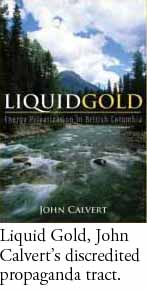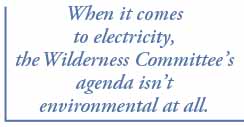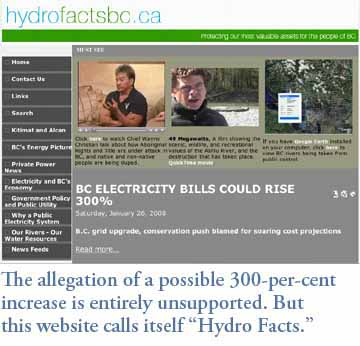
Well-intentioned people have expressed understandable concerns about clean electricity proposals. But most public discussion has been controlled by vested interests and their astroturf groups. As a result lots of misinformation has been propagated, often in an atmosphere of near-hysteria.
That stands in the way of something — a future in which British Columbians can enjoy a sustainable lifestyle that’s envied by the world. So in answer to the frequently heard questions, claims and assertions of a large, well-funded campaign against green energy, we offer some all-too infrequently heard answers.
Q. I keep hearing that 500 or more rivers and streams in B.C. are being sold... or given away... or stolen.
A. That’s completely wrong.
 Q. Well that’s what I keep hearing. How do you account for that?
Q. Well that’s what I keep hearing. How do you account for that?
A. It’s a fictional story that seems to be based on the roughly 450 active water licence applications since about 1990. Those are just applications, not approvals. They represent about one-hundredth of one per cent of B.C.’s rivers and streams. Over 60 of those applications were made by BC Hydro.
During an 18-year period, only about 36 of the proposals were completed. The water licence application is just one step in a process of studies, reviews and consultations that takes at least a few years. The process is so demanding that most proposals never make it.

This myth — that 500 or more B.C. rivers are being sold, given away or stolen — is one of the favourite scare tactics of the well-funded campaign against green energy.
More recently, in examples of inflationary myth-making, the number of rivers has been expanded to 700 and even 750.
Vested interests and their astroturf groups have thoroughly bamboozled people with misinformation on this topic. For more details about water licences, click here.
Q. But what about that map? It has great big dots overlapping each other to show how 500 rivers are being stolen and run-of-river is running amuck...

A. You saw the Gee Whiz Map. It shows all the water licence applications made over the last 18 years or so. But the number of water licence applications has absolutely nothing to do with the number of run-of-river projects.
If that’s not bad enough, the map indicates each application with an oversize dot that greatly exaggerates the size of run-of-river proposals even if those proposals were developed. And, once again, the vast majority of the dots just represent water licence applications, not run-of-river projects.
Q. Okay but isn’t 500, or even 450, a lot?
A. We have something like 12,000 rivers and streams, and that’s not counting the smaller ones that don’t even have names. Even so, we have to remember that only a fraction of those applications ever gets anywhere.
Q. But haven’t water licences been issued more frequently over the last few years?
A. No, only about 10 are issued each year.
 Q. But isn’t this a gold rush? I keep hearing terms like “liquid gold,” “bonanza” and “wild west.”
Q. But isn’t this a gold rush? I keep hearing terms like “liquid gold,” “bonanza” and “wild west.”
A. Those are catchy terms but they hide the fact that most green energy proposals never make it through the long, slow approval process. Each proposal begins with years of feasibility studies, environmental reviews and public consultations. For example, run-of- river proposals have to meet around 50 approvals from between 10 and 20 different agencies at various levels of government. They also undergo consultations and negotiations with First Nations and other stakeholders. In a similar manner, wind and other renewable energy proposals work their way slowly through a long application process. Most proposals don’t even make it through the process. Some “gold rush.”
Q. Speaking of First Nations, don’t they oppose these projects?
A. Different First Nations around the province are considering proposals on an individual basis. They play a key role in the process and take an active part in some projects.
Q. If we need more electricity, why are we exporting the stuff to the U.S.?
A. Fluctuations in supply and demand allow us to sometimes export electricity but BC Hydro figures show we import more than we export and we import from dirty sources. We’ve been doing that for seven of the last eight years. We do that because we haven’t been creating enough new electricity sources for our growing population.
Only in a year with exceptionally high water levels can B.C. create as much electricity as we use.
Q. But if Alberta and Washington want to supply us with dirty power, isn’t that their problem?
A. No, greenhouse gases are everybody’s problem. Global warming doesn’t recognize provincial boundaries. In addition, our lack of self-sufficiency is our problem — and our children’s. We’re taking a foolish risk by staking our children’s future on the increasing prices and decreasing supply of imported electricity.
Q. But can’t we meet future needs just through conservation?
A. No — even if we cut consumption by 10 per cent, BC Hydro says our demand will grow by up to 45 per cent over the next 20 years.
In addition, the movement towards sustainable living actually calls for more electricity for expanded public transit, electric cars and other uses. BC Hydro hasn’t yet factored this into its forecasts.
Q. Don’t we already have underutilized electricity resources like the Burrard Thermal Generating Plant?
A. Sure, but Burrard Thermal is underutilized for a good reason — it’s a major source of GHGs and other forms of air pollution. It’s also very expensive. Burrard Thermal is a throwback to the pre-environmental era and shouldn’t be used at all, except maybe as an emergency backup.
Q. Aren’t green energy projects dangerous experiments with new ideas?
A. Green energy is anything but new. Countries in central and northern Europe have longstanding experience with wind, run-of-river and solar projects within stringent environmental standards. Other countries are also leading the way in wave, tidal, geothermal and other sustainables. Environmental groups in other countries support green energy.
B.C. has an ideal opportunity to learn from others and follow in their footsteps. In fact we can surpass them and create an international example of clean, sustainable energy that will benefit future generations.
Q. But what about the effects of run of river? Green energy isn’t really green, is it?
A. Green energy, run of river, wind and other renewables are an awful lot greener than anything else — especially our traditional sources of energy. How many more valleys can we flood? How much toxic coal- and gas-fired energy can we import? Let’s keep in mind that these projects have proven themselves in northern and central Europe, where they have the support of environmental groups. And here in B.C. they have to prove themselves all over again to anywhere from 10 to 20 government agencies.
It’s so easy for opponents to exaggerate the idea that all development is bad. But it would be just as easy to apply that argument to almost any human endeavour.
Q. What about the cumulative effects of run-of-river proposals? Does anyone consider them?
A. The Canadian Environmental Assessment Agency specifically studies cumulative effects during the review process.
Q. But I’ve heard that the provincial environmental review never rejects a proposal.
A. That’s false. Many proposals have been cancelled because of negative feedback from B.C.’s environmental assessment. At that point companies prefer to drop a proposal than continue to spend money on it and face a formal rejection at the end of the review process.
Q. What about local communities? Didn’t Bill 30 prevent them from having a say?
A. No it didn’t. Local governments, First Nations and other groups do participate at several points during the water licence application, the Crown land tenure application and the environmental assessment process. Public consultation covers environmental, economic, social, heritage and health issues.
Q. What about wind turbines? I’ve heard they kill birds.
 A. The early problems with wind energy have been addressed over the last few decades in northern European countries with strict environmental standards. But a badly designed California development in the 1980s gave some people the impression that the problems continue. The Altamont Pass wind farm in California was built in the pathway of migrating birds. If that’s not bad enough, its turbines were too close to the ground and too close together. This one project is often cited by opponents, when it’s obviously an exception to the rule.
A. The early problems with wind energy have been addressed over the last few decades in northern European countries with strict environmental standards. But a badly designed California development in the 1980s gave some people the impression that the problems continue. The Altamont Pass wind farm in California was built in the pathway of migrating birds. If that’s not bad enough, its turbines were too close to the ground and too close together. This one project is often cited by opponents, when it’s obviously an exception to the rule.
More recently, an Alberta wind farm has been found to cause bats’ deaths. The developer is working on mitigation.
In fact many more birds die in collisions with cars and buildings than are killed by wind turbines. The American Audubon Society states that many more birds are killed by coal-fired electricity plants than by wind farms.
Q. So why do some environmental groups oppose green energy?
The Wilderness Committee says it will support run of river if BC Hydro develops it. That’s not an environmental argument at all. There’s no reason to think BC Hydro could achieve even higher environmental standards than independents. The WC, by the way, works very closely with COPE 378, a BC Hydro union.
It gets even stranger. COPE 378 supports expanded use of Burrard Thermal, which would greatly increase greenhouse gases and other types of air pollution.

When it comes to electricity, the WC’s agenda isn’t environmental at all.
As for the much smaller groups, some of their members mean well. But some groups were set up with money and assistance from COPE 378, a BC Hydro union. COPE 378 and its allies are now trying to set up many more supposedly “grassroots” groups across the province.
European environmental groups support clean electricity, including independently produced clean electricity.
Q. Why can’t BC Hydro develop these projects?
A. Most importantly, the financial risk is much too big for a publicly owned utility spending our own money. Proposals for electricity generation have a very high rate of failure. For example, out of about 650 run-of-river proposals since 1990 only about three dozen have been built. In some cases millions of dollars were spent before a proposal folded. A publicly owned utility can’t risk so much of our money.
Independents’ costs are lower. If you compare the projected cost of the Site C dam proposal with the cost of independent projects and adjust for the amount of electricity to be generated, you’ll see that the independents are significantly cheaper.
BC Hydro lacks expertise in anything but building and maintaining 1960s-style mega-projects. Green energy projects, on the other hand, call for a wide range of expertise that’s foreign to BC Hydro.
BC Hydro lacks the flexibility to juggle lots of relatively small projects at the same time. Each of these projects requires a lengthy process of feasibility studies, environmental reviews and consultations with First Nations and local communities.
Partly for those reasons, BC Hydro neglected our huge potential while other countries were developing green energy.
Q. Won’t green energy projects lead to the privatization of BC Hydro?
A. They can’t — as a Crown corporation, BC Hydro already owns most of B.C.’s generating facilities and it’s going to get bigger. The publicly owned utility is now starting a massive $5.3-billion program of upgrades and expansion, with a 40-per-cent increase in staff. That doesn’t even include the proposed Site C dam, which would be the province’s largest electricity project in decades.
It’s important to remember that BC Hydro already buys dirty energy from independent producers outside the province. No one calls that privatization. But when we suggest buying clean energy from independents inside the province, vested interests pretend it’s privatization.
Q. But won’t private companies or even Americans own our energy resources?
A. No, independent companies don’t own the resources — British Columbians do. The independents get temporary permission to use the resources. Then their permission expires.
For example if a run-of-river operation is approved it gets the right to use a waterway for a fixed period of time. The maximum is 40 years and in many cases the permission expires sooner. When it expires, the province can renew the water rights, grant them to someone else, take over the operation itself or order the company to disband the project.
The myth of privatization or American ownership is another favourite scare tactic in the campaign against green energy. But for a number of reasons, the province has the upper hand over independent companies.
Q. But after the contracts with BC Hydro expire, won’t we have to compete with Americans to buy our own energy?
A. No, the energy supplier will re-negotiate with BC Hydro. Otherwise, as explained above, they could lose their permission to use our resources. In addition, the National Energy Board requires that electricity producers give Canadians priority over exports.
Q. Isn’t it true that BC Hydro contributes to public revenues and private companies don’t?
A. Independent companies do contribute to public revenue, and they contribute big time. Unlike BC Hydro, they pay back over a third of their revenue in taxes and water fees. Don’t forget that the money that was taken from BC Hydro for general spending should have been re- invested in maintaining and building electricity infrastructure. Independents will be responsible for their own re-investment and maintenance while at the same time paying a third of their revenue to the public.
Q. Won’t green energy raise our electricity rates?
 A. Green electricity won’t raise our rates. Like everything else, rates will go up, but B.C. will continue to have among the lowest rates in North America.
A. Green electricity won’t raise our rates. Like everything else, rates will go up, but B.C. will continue to have among the lowest rates in North America.
Rates will go up if we continue to rely on increasingly scarce imported power. It’s going to get much more expensive.
Rates would also go up if BC Hydro developed all the electricity we need. It would cost money to develop that power.
Rates will go up just to pay for badly needed maintenance on B.C.’s badly neglected infrastructure. Electricity from BC Hydro upgrades costs about the same as electricity from new sources.
One of the favourite propaganda tactics of anti-green-energy activists is to use apples-and-oranges comparisons. For example they compare the cost of electricity produced from BC Hydro’s existing sources with the cost from new sources, and then they exaggerate the difference. The existing sources come from infrastructure that was built and paid for long ago. But because BC Hydro hasn’t kept up with demand, we need new sources which will cost money to build.
Independent companies sign long-term purchase agreements at fixed prices for usually 20 to 35 years. These contracts protect consumers. Consumers are also shielded from independents’ cost-overruns. We’ve never been protected from BC Hydro’s own cost-overruns.
As for the projected rate increases, a lot of really fanciful numbers are being thrown around. The actual figures will be much lower.
Q. So what does this controversy come down to, then?
A. British Columbians can continue to serve the status quo. Or we can follow the example of other countries and meet the challenges of the future. In doing so we can even surpass other countries and provide the world with an enviable example of sustainable living. What a wonderful legacy this would be for future generations.